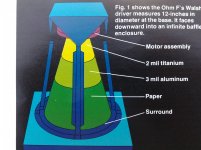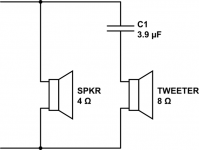I have a refurbished Ohm Walsh F that I am playing around with adding additional BG Neo tweeters to. A Neo8 is pointing towards the listener, and a Neo3 is pointing towards the ceiling.
I have yet to wire all three together. The Neo8 is currently connected in parallel through the internals of an Aperion Audio Super Tweeter (5 Ohm). My plan is to use this to dial in what caps/resistors I need, and then build a similar crossover.
How to add the Neo3, I do not know. Should I do that in series with the Neo8?
I do have a powerful amp stable to 2 Ohm.
Any tips would be appreciated. Thanks.
I have yet to wire all three together. The Neo8 is currently connected in parallel through the internals of an Aperion Audio Super Tweeter (5 Ohm). My plan is to use this to dial in what caps/resistors I need, and then build a similar crossover.
How to add the Neo3, I do not know. Should I do that in series with the Neo8?
I do have a powerful amp stable to 2 Ohm.
Any tips would be appreciated. Thanks.
Why do you want to add tweeters? If the goal is to extend the highs, how about using an equalizer?
Some background information would be of assistance.
The Ohm F uses a bespoke 12” inverted omnidirectional driver operating from 35-17,000 Hz. As such, the Ohm F does not include a tweeter.
Sarsicism would appear to want to add tweeters while adhering to the omnidirectional principle. I presume he perceives the Ohm Fs to be lacking in treble.
The Ohm F uses a bespoke 12” inverted omnidirectional driver operating from 35-17,000 Hz. As such, the Ohm F does not include a tweeter.
Sarsicism would appear to want to add tweeters while adhering to the omnidirectional principle. I presume he perceives the Ohm Fs to be lacking in treble.
Attachments
Sarsicism, can you confirm that these are the versions of the BG Neo tweeters that you have?
https://www.parts-express.com/pedocs/specs/264-718-bohlender-graebener-specifications-44574.pdf
https://www.parts-express.com/pedocs/specs/264-712-bohlender-graebener-neo8-specifications-44578.pdf
https://www.parts-express.com/pedocs/specs/264-718-bohlender-graebener-specifications-44574.pdf
https://www.parts-express.com/pedocs/specs/264-712-bohlender-graebener-neo8-specifications-44578.pdf
Yes, those are the tweeters.
The general thinking behind this project is to have the Neo8 bring a bit more imaging by facing the listener, and the Neo3 adding some vertical spaciousness by pointing at the ceiling.
The newer Ohm designs utilize a "super tweeter" that is angled inwards about 45 degrees, and upwards about 20 degrees. So you could say I am making a hybrid of old and new designs, trying to retain the Ohm F strengths and enhance areas that could use a bit of help.
The Ohm F by itself is a great speaker, but it s a 50 year old design that has limitations.
The general thinking behind this project is to have the Neo8 bring a bit more imaging by facing the listener, and the Neo3 adding some vertical spaciousness by pointing at the ceiling.
The newer Ohm designs utilize a "super tweeter" that is angled inwards about 45 degrees, and upwards about 20 degrees. So you could say I am making a hybrid of old and new designs, trying to retain the Ohm F strengths and enhance areas that could use a bit of help.
The Ohm F by itself is a great speaker, but it s a 50 year old design that has limitations.
The Aperion Audio is a true super tweeter which crosses over around 8,000Hz and extends all the way up to 30,00Hz.
The Neo tweeters are not super tweeters and don't claim to go higher than 20,000Hz.
They can be crossed over at much lower frequencies than the Aperion (500Hz; Neo 8 and 1,000Hz; Neo 3).
At what frequency would you want each of the Neo tweeters to cross over in your application - the same frequency for each or different frequencies?
Apart from choosing the crossover frequency, there is also the mismatch in sensitivity to cater for (Ohm F; 86dB, Neo 8&3; 93dB).
The Neo tweeters are not super tweeters and don't claim to go higher than 20,000Hz.
They can be crossed over at much lower frequencies than the Aperion (500Hz; Neo 8 and 1,000Hz; Neo 3).
At what frequency would you want each of the Neo tweeters to cross over in your application - the same frequency for each or different frequencies?
Apart from choosing the crossover frequency, there is also the mismatch in sensitivity to cater for (Ohm F; 86dB, Neo 8&3; 93dB).
I think the crossover is going to be something that I play with. I have a MiniDSP SHD feeding the system, but I would like to preserve 2 channel amplification.
Using the Neo8 with the Aperion set at 8000Hz and 0DB sounds pretty good.
The Neo3 can stay around there as well.
Basically I am looking for a starting point as to how to "power" everything, and then I will dial in the resistance and crossover points.
Using the Neo8 with the Aperion set at 8000Hz and 0DB sounds pretty good.
The Neo3 can stay around there as well.
Basically I am looking for a starting point as to how to "power" everything, and then I will dial in the resistance and crossover points.
O.K. Wire the two tweeters in series to give 8Ω. Then use a simple 2nd order crossover to drive the combination.
This will require a 0.18mH inductor in parallel with the tweeter combination and a 1.5μF NP capacitor in series with that combination. This will give a crossover frequency of around 7,000Hz.
If the tweeters are too loud you can add an L-pad attenuator between the LC crossover and the tweeter combination.
This should work well. A more complex crosover would not be suitable for your application.
This will require a 0.18mH inductor in parallel with the tweeter combination and a 1.5μF NP capacitor in series with that combination. This will give a crossover frequency of around 7,000Hz.
If the tweeters are too loud you can add an L-pad attenuator between the LC crossover and the tweeter combination.
This should work well. A more complex crosover would not be suitable for your application.
Thank you... so the tweeters in series with each other, and that in parallel with the main driver?
Would a L-Pad be required if I had digital equalization? I could just use that to bring down the top end where it starts to rise above "flat", correct?
If the digital equalisation works for you then there is no need for an L-pad. It is not a required component in the crossover.
The advantage of an L-pad is that the speaker can be made flat independent of digital equalisation and therefore compatible with any amplification system.
If required, I suggest a variable L-pad control which is easy to incorporate as shown in the following link:
Speaker L-Pad Attenuator 100W Mono 1" Shaft 8 Ohm
The advantage of an L-pad is that the speaker can be made flat independent of digital equalisation and therefore compatible with any amplification system.
If required, I suggest a variable L-pad control which is easy to incorporate as shown in the following link:
Speaker L-Pad Attenuator 100W Mono 1" Shaft 8 Ohm
I should add that an L-pad attenuates all the high frequencies by the same amount, maintaining them all at the level that matches the main speaker.
A simple treble control would slope off the treble, affecting the highest frequencies most and producing a falling treble response.
If your digital equalisation can emulate the L-pad, then fair enough.
A simple treble control would slope off the treble, affecting the highest frequencies most and producing a falling treble response.
If your digital equalisation can emulate the L-pad, then fair enough.
Last edited:
I fear a tweeter pointing towards a listener will be "too focused and directional", besides being too loud.
Just thinking aloud, and to keep along the original Ohm concept: an omnidirectional conical transducer oriented on a vertical axis and radiating radially, I would add just one Tweeter, pointing upwards towards a reflecting hard cone, say glass, marble or similar; it would become equivalent to a cone radiating omnidirectionally, just reaching higher frequencies.
Just thinking aloud, and to keep along the original Ohm concept: an omnidirectional conical transducer oriented on a vertical axis and radiating radially, I would add just one Tweeter, pointing upwards towards a reflecting hard cone, say glass, marble or similar; it would become equivalent to a cone radiating omnidirectionally, just reaching higher frequencies.
The Neo8 isn’t being pointed directly at the listener, but pretty close. It is a nice addition.
Bouncing the Neo3 off the ceiling avoids timing issues and cone filtering as it gets diffused slightly and has to travel farther to the ear.
Galu, if I wanted to have them crossed lower, would both the cap and inductor need to be changed?
Bouncing the Neo3 off the ceiling avoids timing issues and cone filtering as it gets diffused slightly and has to travel farther to the ear.
Galu, if I wanted to have them crossed lower, would both the cap and inductor need to be changed?
If I wanted to maximize the range of the Neo3, I think they would be crossed at 2000Hz. What would be needed for that (doing the same for the Neo8)?
Using the standard values of capacitors and inductors available to buy you would need 6.8μF and 0.9mH.
Choose a polypropylene capacitor and an air cored inductor.
Choose a polypropylene capacitor and an air cored inductor.
Crossing over to the tweeters as low as 2,000Hz risks them being too prominent and masking the character of the main speaker too much.
If you want to crossover lower, a suitable compromise might be 3.3μF/0.4mH, giving a crossover of around 4,500Hz.
Remember that the 4,500Hz is not a sharp cut off frequency, the tweeters will produce a gradually falling output below that frequency.
Obviously, there is room for experimentation here and your ears will be the arbiters!
If you want to crossover lower, a suitable compromise might be 3.3μF/0.4mH, giving a crossover of around 4,500Hz.
Remember that the 4,500Hz is not a sharp cut off frequency, the tweeters will produce a gradually falling output below that frequency.
Obviously, there is room for experimentation here and your ears will be the arbiters!
- Status
- Not open for further replies.
- Home
- Loudspeakers
- Multi-Way
- Wiring Help: 4 Ohm 12" + Two 4 Ohm Planar Tweeters


